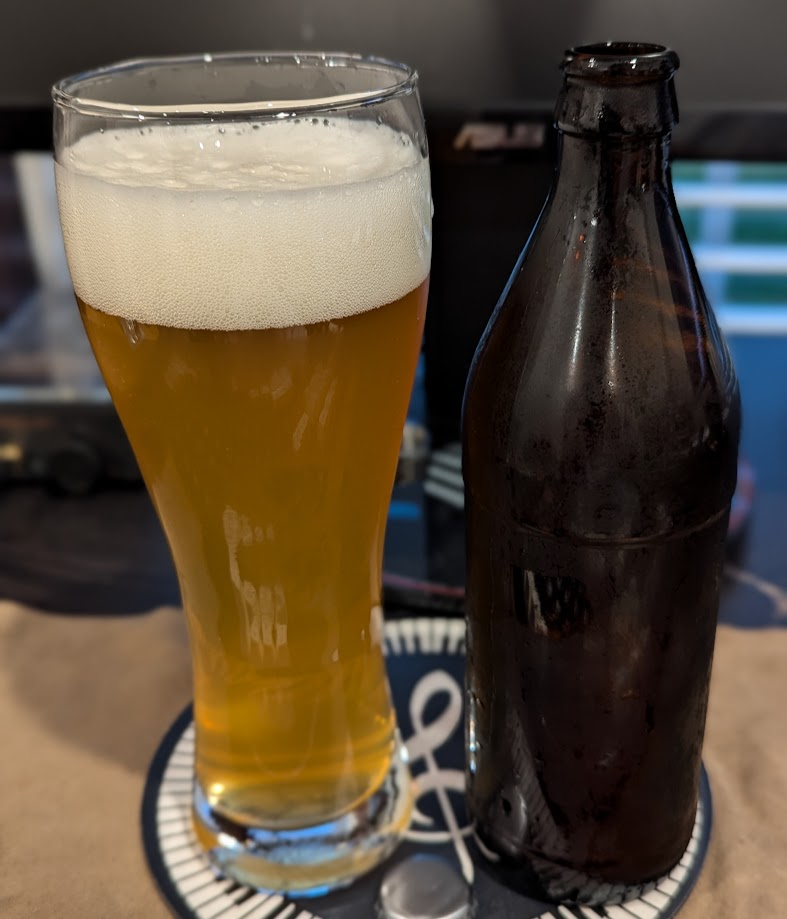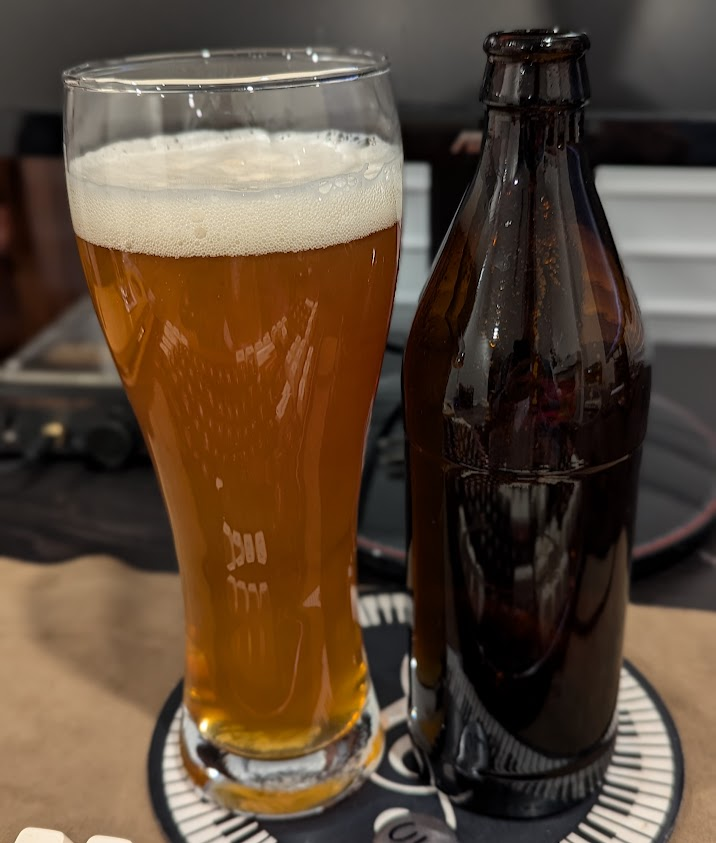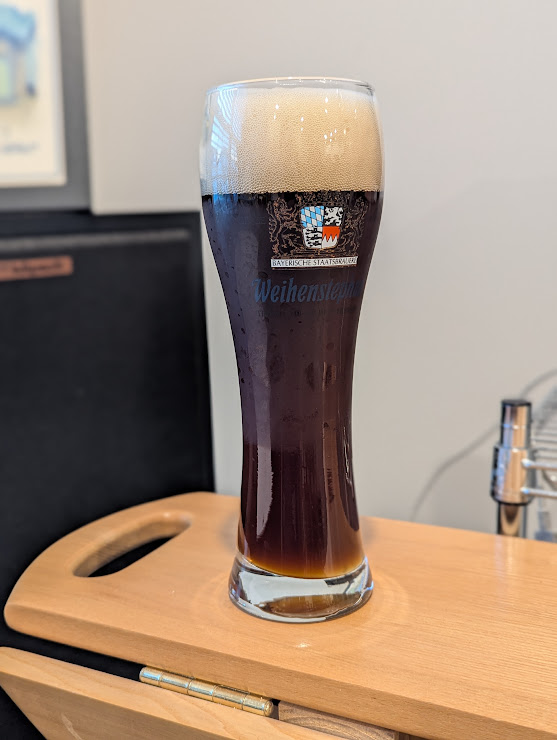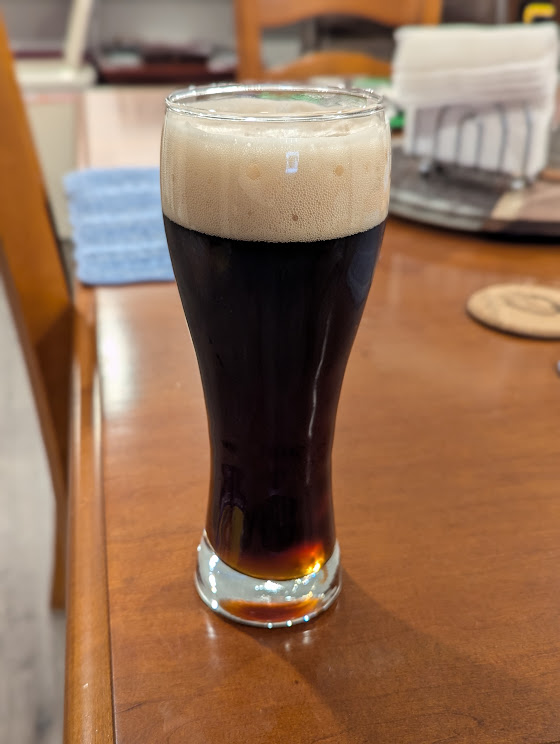Good performance from the dry yeast at 1.008
You are using an out of date browser. It may not display this or other websites correctly.
You should upgrade or use an alternative browser.
You should upgrade or use an alternative browser.
NEW!!: Safale W-68 Dry Yeast
- Thread starter AlcheMania
- Start date

Help Support Homebrew Talk:
This site may earn a commission from merchant affiliate
links, including eBay, Amazon, and others.
I like this yeast, but it's not WLP-300. It's more tart and the banana is a little different. It does make a good flavorful beer.

Update: I can confidently say this is the best hefeweizen I have ever brewed. The moment the beer was poured into the glass, an intense aroma of bananas immediately hit my nose. The aroma is sweet and very banana-forward with a slightly bready quality from the light munich I prefer to use over the Carahell that Weihenstephan supposedly uses. The cloves come across in the flavor, noticeable spicy bite. IBU's are just right. Sulfur is very low for the style, significantly lower than what I was getting with the Omega version of W68. Additionally the beer is not too tart or overly citrusey.
I would use this exact fermentation temperature and pitch rate again. I think if I was to ferment any hotter, I would risk excessive fusel alcohol production, which this strain is very prone to in my experience.
The batch details are all contained here:
https://share.brewfather.app/yFXBxCrJbeXX8q
I said it before, I'll say it again: Franziskaner Dunkel Weisse
-thanx for the info, a great help!
-thanx for the info, a great help!
AlcheMania
Well-Known Member
Yep. mine brewed at 66 ish and was def clove dominant and lacking in banana. Thanks for the udpate!!View attachment 858603
Update: I can confidently say this is the best hefeweizen I have ever brewed. The moment the beer was poured into the glass, an intense aroma of bananas immediately hit my nose. The aroma is sweet and very banana-forward with a slightly bready quality from the light munich I prefer to use over the Carahell that Weihenstephan supposedly uses. The cloves come across in the flavor, noticeable spicy bite. IBU's are just right. Sulfur is very low for the style, significantly lower than what I was getting with the Omega version of W68. Additionally the beer is not too tart or overly citrusey.
I would use this exact fermentation temperature and pitch rate again. I think if I was to ferment any hotter, I would risk excessive fusel alcohol production, which this strain is very prone to in my experience.
The batch details are all contained here:
https://share.brewfather.app/yFXBxCrJbeXX8q

So here's that second version of my above hefeweizen where all I did was swap the white wheat malt for Weyermann dark wheat malt. I was shooting for 5.8% where the original version above came out at 5.5%. It ended up going from 1.055 to 1.009, for a result of 6.0%.
My observations:
-It's always incredible to me with this yeast how as soon as you push the OG past a certain tipping point, that this strain starts throwing some pretty crazy esters, and this one is for sure in Weizenbock territory in terms of not just yeast expression but in terms of just being way bigger on flavor. Bottom line there's some bubblegum to go with the bananas. It's definitely not like the Ayinger Urweisse at all - I will need to either prop up their strain somehow or try a different strain in the future. Their ester profile is very different. But bottom line, I went with the same pitch rate exactly as the hefeweizen above and the esters are crazy. Keep the pitch rate LOW - 6 grams per 5 gallons, keep the temperature higher - 68F+, and keep the pressure low.
-Despite the SRM being 7.7 vs 5.4 (hefeweizen above) on paper, you can tell this is simply way darker than it should be. My guess, Weyermann's Light Munich tends to run lighter than their specs suggest, as my hefeweizen above is pretty pale for something with 2.5 pounds of Munich malt in it.
-I don't like the malt character, frankly. It's just too much for a Hefeweizen. Weyermann's dark wheat should basically just be a munich malt on paper, but it's much sweeter, a bit less bready. I prefer actual munich malt. Not that it's bad, I've medaled with a similar beer to this in the past, and I'm sure this one will also medal as a weizenbock. But the assault of the esters and sweet maltiness combined just affects drinkability to a degree. If I were forced to brew this exact beer again, I would pull a Schneider-Weisse and hop it up like their Hopfenweisse which is an absolutely brilliant beer. That would give some bitterness and phenolics to stand up to the malt and ester sweetness.

$172.35
2 Inch Tri Clamp Keg Manifold With Ball Lock Posts, Pressure Gauge, PRV (0-30 PSI) – Homebrew, Fermentation, Kegging System
wuhanshijiayangzhiyimaoyiyouxiangongsi

$7.79 ($7.79 / Count)
Craft A Brew - LalBrew Voss™ - Kveik Ale Yeast - For Craft Lagers - Ingredients for Home Brewing - Beer Making Supplies - (1 Pack)
Craft a Brew

$20.94
$29.99
The Brew Your Own Big Book of Clone Recipes: Featuring 300 Homebrew Recipes from Your Favorite Breweries
Amazon.com

$176.97
1pc Commercial Keg Manifold 2" Tri Clamp,Ball Lock Tapping Head,Pressure Gauge/Adjustable PRV for Kegging,Fermentation Control
hanhanbaihuoxiaoshoudian

$39.22 ($39.22 / Count)
Brewer's Best Home Brew Beer Ingredient Kit - 5 Gallon (Mexican Cerveza)
Amazon.com

$53.24
1pc Hose Barb/MFL 1.5" Tri Clamp to Ball Lock Post Liquid Gas Homebrew Kegging Fermentation Parts Brewer Hardware SUS304(Liquid MFL)
yunchengshiyanhuqucuichendianzishangwuyouxiangongsi

$58.16
HUIZHUGS Brewing Equipment Keg Ball Lock Faucet 30cm Reinforced Silicone Hose Secondary Fermentation Homebrew Kegging Brewing Equipment
xiangshuizhenzhanglingfengshop

$10.99 ($31.16 / Ounce)
Hornindal Kveik Yeast for Homebrewing - Mead, Cider, Wine, Beer - 10g Packet - Saccharomyces Cerevisiae - Sold by Shadowhive.com
Shadowhive

$53.24
1pc Hose Barb/MFL 1.5" Tri Clamp to Ball Lock Post Liquid Gas Homebrew Kegging Fermentation Parts Brewer Hardware SUS304(Liquid Hose Barb)
Guangshui Weilu You Trading Co., Ltd

$27.29 ($13.64 / Count)
$41.99 ($21.00 / Count)
2 Pack 1 Gallon Large Fermentation Jars with 3 Airlocks and 2 SCREW Lids(100% Airtight Heavy Duty Lid w Silicone) - Wide Mouth Glass Jars w Scale Mark - Pickle Jars for Sauerkraut, Sourdough Starter
Qianfenie Direct

$22.00 ($623.23 / Ounce)
AMZLMPKNTW Ball Lock Sample Faucet 30cm Reinforced Silicone Hose Secondary Fermentation Homebrew Kegging joyful
无为中南商贸有限公司
AlcheMania
Well-Known Member
Thanks for the update!View attachment 860474
So here's that second version of my above hefeweizen where all I did was swap the white wheat malt for Weyermann dark wheat malt. I was shooting for 5.8% where the original version above came out at 5.5%. It ended up going from 1.055 to 1.009, for a result of 6.0%.
My observations:
-It's always incredible to me with this yeast how as soon as you push the OG past a certain tipping point, that this strain starts throwing some pretty crazy esters, and this one is for sure in Weizenbock territory in terms of not just yeast expression but in terms of just being way bigger on flavor. Bottom line there's some bubblegum to go with the bananas. It's definitely not like the Ayinger Urweisse at all - I will need to either prop up their strain somehow or try a different strain in the future. Their ester profile is very different. But bottom line, I went with the same pitch rate exactly as the hefeweizen above and the esters are crazy. Keep the pitch rate LOW - 6 grams per 5 gallons, keep the temperature higher - 68F+, and keep the pressure low.
-Despite the SRM being 7.7 vs 5.4 (hefeweizen above) on paper, you can tell this is simply way darker than it should be. My guess, Weyermann's Light Munich tends to run lighter than their specs suggest, as my hefeweizen above is pretty pale for something with 2.5 pounds of Munich malt in it.
-I don't like the malt character, frankly. It's just too much for a Hefeweizen. Weyermann's dark wheat should basically just be a munich malt on paper, but it's much sweeter, a bit less bready. I prefer actual munich malt. Not that it's bad, I've medaled with a similar beer to this in the past, and I'm sure this one will also medal as a weizenbock. But the assault of the esters and sweet maltiness combined just affects drinkability to a degree. If I were forced to brew this exact beer again, I would pull a Schneider-Weisse and hop it up like their Hopfenweisse which is an absolutely brilliant beer. That would give some bitterness and phenolics to stand up to the malt and ester sweetness.
I have an open ferm setup in the works to try out this strain again. I def want to get more banana than the bubble gum that comes from the higher ferm temps and OG. My first batch was phenolic over banana but was keg firmed @65 F
Planned brew date Dec 28th.
Great thread. I’m fermenting a dunkelweizen with w-68. Cooled wort down to 60f, pitched 3 packets (6 gal batch) and let free rise to 71 at peak fermentation. Big pitch on 1.048 wort.. Letting this finish up and can’t wait to drink. I’ll try to remember to report back w/ yeast flavors
Great thread. I’m fermenting a dunkelweizen with w-68. Cooled wort down to 60f, pitched 3 packets (6 gal batch) and let free rise to 71 at peak fermentation. Big pitch on 1.048 wort.. Letting this finish up and can’t wait to drink. I’ll try to remember to report back w/ yeast flavors
Why did you pitch so much? I cannot imagine you will get any significant ester character with that much of an overpitch.
I was expecting a higher final gravity (1.056)… even then I understand it’s still a healthy pitch (didn’t read SG until Tilt was tossed in). We’ll see. Will likely harvest the yeast and brew again anyway so.. experiment it is. I haven’t overpitched a hefe to tell you the esters will be completely gone, but have underpitched and warm fermented a hefe and still haven’t gotten the banana I wanted. If it lacks flavor I’ll be severely underpitching the next one lol. On the bright side, I’ll have hefe yeast for a whileWhy did you pitch so much? I cannot imagine you will get any significant ester character with that much of an overpitch.
Last edited:
Overpitching weizen yeast makes the beer cleaner. One packet should be the correct amount for a 5-6 gallon normal strength hefe.
That's a waste of about 2.5 packs of yeast. Seriously, I would have pitched no more than 1/2 a pack. Save money and get more flavor.pitched 3 packets (6 gal batch) and let free rise to 71 at peak fermentation. Big pitch on 1.048 wort.
I hear youThat's a waste of about 2.5 packs of yeast. Seriously, I would have pitched no more than 1/2 a pack. Save money and get more flavor.
I haven't posted in here in a while. I continue to make pristine authentic Bavarian style wheat beer with this yeast, at the same pitch rate (1 gram per gallon), with various fermentation profiles. I am absolutely in love with this Dunkelweizen I just made. Even though it's dark in color, it goes down just as easily as any of my Hefeweizens. Give this recipe a shot. It's a winner.

https://share.brewfather.app/HUboMt91wpbEAG
The key with these styles is getting them DRY. I want to see 1.008 on the hydrometer, 1.010 at the absolute maximum.

https://share.brewfather.app/HUboMt91wpbEAG
The key with these styles is getting them DRY. I want to see 1.008 on the hydrometer, 1.010 at the absolute maximum.
Thanks for sharing. I agree, the more I brew the more I aim for strong attenuation.
AlcheMania
Well-Known Member
Thanks for the update! I've fallen off the w-68 brewing after getting more into hazies and pils for the hot months But plan on having a big Weizenbock ready end of September!I haven't posted in here in a while. I continue to make pristine authentic Bavarian style wheat beer with this yeast, at the same pitch rate (1 gram per gallon), with various fermentation profiles. I am absolutely in love with this Dunkelweizen I just made. Even though it's dark in color, it goes down just as easily as any of my Hefeweizens. Give this recipe a shot. It's a winner.
View attachment 879552
https://share.brewfather.app/HUboMt91wpbEAG
The key with these styles is getting them DRY. I want to see 1.008 on the hydrometer, 1.010 at the absolute maximum.
Sipina
Well-Known Member
- Joined
- Aug 12, 2020
- Messages
- 116
- Reaction score
- 60
I just bought this W-68 yeast to try it out in my attempt to make some hefeweizen.
I've been recently trying out some different classical hefeweizens and had noticed that most of, if not all of them had the banana aroma and flavor quite restrained. It was there but quite subtle, I had to look for it a bit so to speak. I found these beer much more dominant on the phenolic side paired with lovely wheat malt flavors and aromas. The beers I had tried were Schneider dunkel, Ayinger Brauweise, Franziskaner HefeWeiss, Weihenstephaner and some others which I can name here later. Is that normal or am I getting these beers not fresh enough? Supposedly the isoamyl acetate can disapear relatively quickly.
I am familiar with doing a ferulic acid rest in general. I'm wondering what kind of profile regarding phenolics do you guys/girls get from the W-68 yeast? Is it strong on phenolics? Should I do the ferulic acid rest or would I be making a totally unbalanced beer? I've read that some of these german wheat beers can be more or less expressive on either banana or clove side. I do like the banana restrained like in the beers I had tried and that's the profile I'm looking for.
I've been recently trying out some different classical hefeweizens and had noticed that most of, if not all of them had the banana aroma and flavor quite restrained. It was there but quite subtle, I had to look for it a bit so to speak. I found these beer much more dominant on the phenolic side paired with lovely wheat malt flavors and aromas. The beers I had tried were Schneider dunkel, Ayinger Brauweise, Franziskaner HefeWeiss, Weihenstephaner and some others which I can name here later. Is that normal or am I getting these beers not fresh enough? Supposedly the isoamyl acetate can disapear relatively quickly.
I am familiar with doing a ferulic acid rest in general. I'm wondering what kind of profile regarding phenolics do you guys/girls get from the W-68 yeast? Is it strong on phenolics? Should I do the ferulic acid rest or would I be making a totally unbalanced beer? I've read that some of these german wheat beers can be more or less expressive on either banana or clove side. I do like the banana restrained like in the beers I had tried and that's the profile I'm looking for.
Last edited:
Sounds like my type of yeast! I like Schneider Weisse, I think the regular is called Nr. 7. That also has virtually zero banana but a lot of clove.I just bought this W-68 yeast to try it out in my attempt to make some hefeweizen.
I've been recently trying out some different classical hefeweizens and had noticed that most of, if not all of them had the banana aroma and flavor quite restrained. It was there but quite subtle, I had to look for it a bit so to speak. I found these beer much more dominant on the phenolic side paired with lovely wheat malt flavors and aromas. The beers I had tried were Schneider dunkel, Ayinger Brauweise, Franziskaner HefeWeiss, Weihenstephaner and some others which I can name here later. Is that normal or am I getting these beers not fresh enough? Supposedly the isoamyl acetate can disapear relatively quickly.
I am familiar with doing a ferulic acid rest in general. I'm wondering what kind of profile regarding phenolics do you guys/girls get from the W-68 yeast? Is it strong on phenolics? Should I do the ferulic acid rest or would I be making a totally unbalanced beer? I've read that some of these german wheat beers can be more or less expressive on either banana or clove side. I do like the banana restrained like in the beers I had tried and that's the profile I'm looking for.
I haven't had many Weissbier that were really dominant on banana. Usually they are a bit restrained. Don't tell anyone, but we add a bit of banana juice if we want more banana, here in Germany
I am disappointed in the attenuation of this yeast. I brewed a smoked dunkelweizen that started at 1.050 and finished at 1.015 for 68% attenuation. Mashed at 147 for 30 minutes and 162 for 30 minutes and used 1 package of yeast. Water chemistry was adjusted properly and fermented between 68 and 71 degrees. It's conditioning now so I haven't had a chance to taste it yet.
Granted, this is the first time I did a 147/162 mash.
What's everyone else getting for attenuation with this yeast?
Granted, this is the first time I did a 147/162 mash.
What's everyone else getting for attenuation with this yeast?
I am disappointed in the attenuation of this yeast. I brewed a smoked dunkelweizen that started at 1.050 and finished at 1.015 for 68% attenuation. Mashed at 147 for 30 minutes and 162 for 30 minutes and used 1 package of yeast. Water chemistry was adjusted properly and fermented between 68 and 71 degrees. It's conditioning now so I haven't had a chance to taste it yet.
Granted, this is the first time I did a 147/162 mash.
What's everyone else getting for attenuation with this yeast?
Around 83%. You probably didn't hold your beta rest for long enough. I hold at 147 for 75 minutes with my system. Either that or your rauchmalt is just not very fermentable.
You might be right, first time I used an oak smoked wheat, about 19%. I know at 152 you don't get much more extraction after about 45 minutes. Thanks.
Sipina
Well-Known Member
- Joined
- Aug 12, 2020
- Messages
- 116
- Reaction score
- 60
I don't like to keep opened sachets of yeast around therefore I intend to pitch the whole 11g of W68 yeast into wort. I might make it around 1.050 starting gravity and I am looking to get the more clove dominant profile in my hefeweizen. I believe the 11g pitch is considered a bit of a overpitch however it should work well to get the clove profile? Is that correct or am I thinking wrong?
Cheers!
Cheers!
Overpitching would favor the clove vs banana. You can ferment cooler to favor the clove as well. Say 62F.
I am always unclear on how many actual cells are in dry yeast packets. So pitching the entire packet is not necessarily a bad thing. The best approach is to pitch the entire packet, pick a fermentation temperature and see how it turns out. Then adjust for your next brew.
I am always unclear on how many actual cells are in dry yeast packets. So pitching the entire packet is not necessarily a bad thing. The best approach is to pitch the entire packet, pick a fermentation temperature and see how it turns out. Then adjust for your next brew.
Sipina
Well-Known Member
- Joined
- Aug 12, 2020
- Messages
- 116
- Reaction score
- 60
That's what I have thought. I'll make the usual wort I make with 50% wheat malt, including ferulic acid rest, and proceed with pitching the whole sachet and ferment in the basement at around 20-22 degrees celsius. Will report on the results here.Overpitching would favor the clove vs banana. You can ferment cooler to favor the clove as well. Say 62F.
I am always unclear on how many actual cells are in dry yeast packets. So pitching the entire packet is not necessarily a bad thing. The best approach is to pitch the entire packet, pick a fermentation temperature and see how it turns out. Then adjust for your next brew.
I like to push the wheat to 60 or 65% to bring out the wheat flavor. As well as double mill just the wheat. But that is if your system can lauter this without a stuck mash.
Sipina
Well-Known Member
- Joined
- Aug 12, 2020
- Messages
- 116
- Reaction score
- 60
Great tip! Will consider that for sure. I have rice hulls on hand so I should be safe enough regarding lautering. The other half of the grain will be pilnser malt which should let the wheat flavor shine I presume.I like to push the wheat to 60 or 65% to bring out the wheat flavor. As well as double mill just the wheat. But that is if your system can lauter this without a stuck mash.
Yep. The wheat, if a large enough percentage of the grain bill, adds a unique character imho. Kind of tangy/spicy? I just try to make the hefeweizen taste different from the barley beers as it is a unique style.
Yep. The wheat, if a large enough percentage of the grain bill, adds a unique character imho. Kind of tangy/spicy? I just try to make the hefeweizen taste different from the barley beers as it is a unique style.
I've found the tanginess level of the wheat varies a lot depending on what variety it is and where it's grown. Red wheat's tangier than white but the red wheat I get locally from Epiphany maltings is pretty mild, more similar to Briess's white wheat.
Also, I rebrewed that Dunkelweizen after housing the last keg. Version 2 is identical other than using Briess's Midnight Wheat rather than Weyermann's Chocolate Wheat ounce for ounce. As a result, it's darker but slightly less chocolatey tasting, coming across more like dutch-processed cocoa. I preferred the Weyermann but this is still plenty crushable.
Interestingly, this was keg conditioned after only two weeks in primary and is free of sulfur. Also, the keg was fully carbonated after only 9 days conditioning. I experimented with starting keg conditioning on my latest Hefeweizen after I think only 9 days in primary, two days ago.
Bottom line I just continue to be impressed with how consistently and "well" this Fermentis W-68 performs, even at very low pitch rates. It's been a game changer for me.

Fermentis did a presentation for our Homebrew Club on their dry yeast, and they told us, at least for W-68, to pitch half a pack at 80F, then continue to chill wort to fermentation temp. In case that helps anyone. I'm brewing a Hefe with it in the next few weeks, and I'm planning to ferment at 72 straight through to push more banana than clove.
Similar threads
- Replies
- 6
- Views
- 678














![Craft A Brew - Safale BE-256 Yeast - Fermentis - Belgian Ale Dry Yeast - For Belgian & Strong Ales - Ingredients for Home Brewing - Beer Making Supplies - [3 Pack]](https://m.media-amazon.com/images/I/51bcKEwQmWL._SL500_.jpg)













